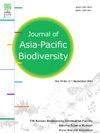Wild pollinator (Hymenoptera: Aculeata) assemblage structures depending on forest habitat types and trap heights
IF 0.7
Q4 BIODIVERSITY CONSERVATION
引用次数: 0
Abstract
Wild pollinators play a crucial role in ecosystems, but their populations are declining globally. This study examined wild pollinator assemblages, especially bees and wasps (Hymenoptera: Aculeata), in different forest habitat types and at various trap heights in the Gwangneung Forest. For the sampling of wild pollinators during the summer season, yellow and white pan traps were installed at four heights (0 cm, 50 cm, 100 cm, and 150 cm) in three habitat types (herbaceous area, deciduous broad-leaved forest, and coniferous forest). A total of 280 wild pollinators representing 62 species from 16 families were collected. Species richness was the highest in herbaceous areas and the lowest in coniferous forests. While trap height did not significantly affect species richness, it did influence species composition, with significant differences observed between traps separated by at least 100 cm. Pollinator assemblages were significantly different across the three habitats. Abundant families showed habitat preferences likely related to larval feeding habits. The results have implications for pollinator monitoring methodologies in forest ecosystems, indicating that sampling across diverse conditions may provide a more comprehensive representation of wild pollinator assemblages.
野生传粉昆虫(膜翅目:针叶目)的组合结构取决于森林生境类型和陷阱高度
野生传粉媒介在生态系统中发挥着至关重要的作用,但它们的数量在全球范围内正在下降。本文研究了广陵森林不同生境类型和不同陷阱高度的野生传粉媒介组合,特别是蜜蜂和黄蜂(膜翅目:针叶蜂)。在夏季采集野生传粉媒介时,在草本区、落叶阔叶林和针叶林3种生境类型中,分别在0、50、100、150 cm 4个高度设置黄色和白色捕集盘。共采集到16科62种280只野生传粉昆虫。物种丰富度以草本区最高,针叶林区最低。陷阱高度对物种丰富度没有显著影响,但对物种组成有显著影响,间隔至少100 cm的陷阱之间差异显著。传粉者组合在不同生境间存在显著差异。大量家庭表现出栖息地偏好,可能与幼虫的摄食习性有关。研究结果对森林生态系统中传粉媒介的监测方法具有重要意义,表明在不同条件下取样可能提供更全面的野生传粉媒介组合代表。
本文章由计算机程序翻译,如有差异,请以英文原文为准。
求助全文
约1分钟内获得全文
求助全文
来源期刊

Journal of Asia-Pacific Biodiversity
Agricultural and Biological Sciences-Insect Science
CiteScore
1.70
自引率
12.50%
发文量
94
审稿时长
27 days
期刊介绍:
The Journal of Asia-Pacific Biodiversity (previous title was Journal of Korean Nature) is an official journal of National Science Museum of Korea (NSMK) and Korea National Arboretum (KNA). The scope of journal is wide and multidisciplinary that publishes original research papers, review articles, as well as conceptual, technical and methodological papers on all aspects of biological diversity-its description, analysis and conservation, and its application by humankind. This wide and multidisciplinary journal aims to provide both scientists and practitioners in conservation theory, policy and management with comprehensive and applicable information. However, papers should not be submitted that deal with microorganisms, except in invited paper. Articles that are focused on the social and economical aspects of biodiversity will be normally not accepted.
 求助内容:
求助内容: 应助结果提醒方式:
应助结果提醒方式:


